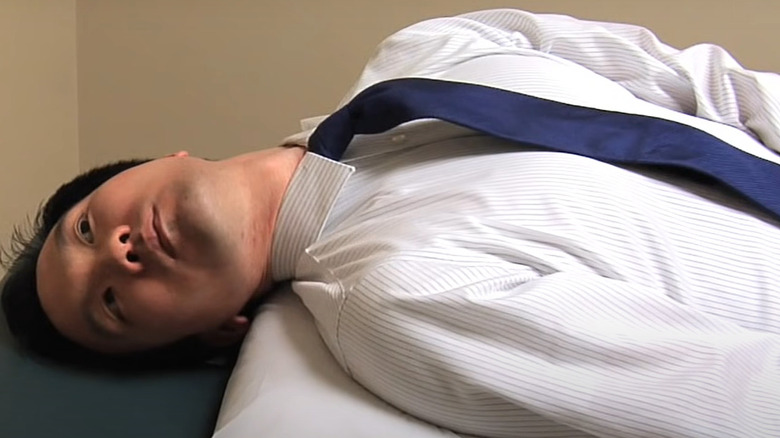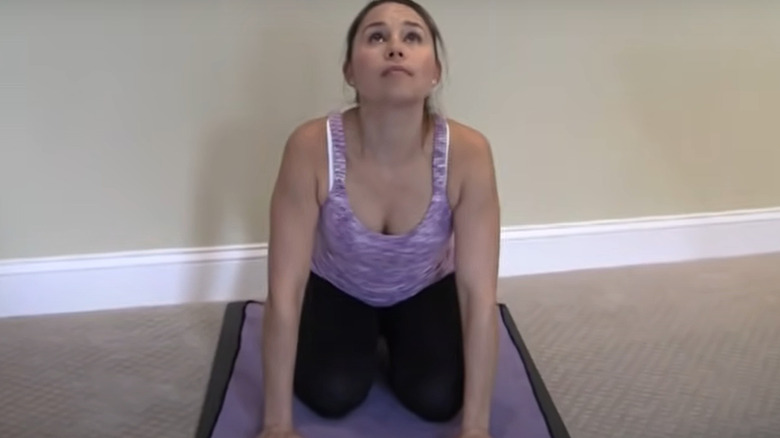5 Exercises That May Help Your Vertigo
While many people believe that vertigo is a health condition that causes feelings of dizziness, it is actually just a symptom of other underlying problems, explains WebMD. Those who experience vertigo — or the sensation of being off-balance and feeling as if the environment is spinning in circles — typically have an issue within the inner ear. This is because the inner ear is responsible for balance, containing a combination of fluid and small hairs. They work together to transmit motion and the position of your head as it pertains to gravity to the brain, as per the Mayo Clinic. Unfortunately, this sensitive balancing system can make you feel as if you're spinning when you're not.
WebMD points out specific conditions affecting the inner ear that can lead to vertigo. One common cause is benign paroxysmal positional vertigo (BPPV), which involves the abnormal collection of calcium particles in the inner ear. Vestibular neuritis stems from a viral infection that causes the inner ear to become inflamed, while Meniere's disease creates an excessive amount of fluid in the inner ear. In some cases, the inner ear might become damaged due to a head injury, a stroke or tumor, or as a side effect of specific medications.
Depending on the cause of your vertigo, there are various treatment options available. One great way to manage the symptom is to engage in balance exercises (per WebMD).
Brandt-Daroff exercises
If the underlying cause of your vertigo is benign paroxysmal positional vertigo (BPPV), giving Brandt-Daroff exercises a try is a great way to alleviate the dizziness. Healthline explains that this type of exercise specifically helps diffuse the small particles of calcium that accumulate in the inner ear and throw off balance perception. A 2014 study published in The Egyptian Journal of Otolaryngology found that Brandt-Daroff exercises were successful in 80% of patients treated who suffered from BPPV.
Brandt-Daroff exercises are easy to carry out and can be done without much effort on your part. The National Health Service explains that you can begin by sitting down, preferably on a bed or couch. Once seated, position your head to the left, turning it about 45 degrees. Next, lay on your right side and stay there for 30 seconds. Repeat the above steps on the other side for five total cycles. For the greatest effectiveness, engage in this exercise three times a day over the course of two weeks. You should also be aware that while carrying out the exercise, you will likely feel an increase in dizziness, so you should take each step slowly.
Gaze stabilization
Another exercise to minimize unpleasant vertigo is known as gaze stabilization. Ear & Balance explains that this exercise can be done by anyone experiencing problems with the inner ear. It can be successful in resetting your balance perception by activating a specific coordination exercise between your eyes, brain, and inner ear. A 2010 study published in the Journal of Neurologic Physical Therapy also confirmed the positive outcomes of this exercise after looking at its effects on motion sensitivity and symptom impact in affected individuals. In all patients tested, there were notable improvements.
To begin, you'll need to gather a few supplies, including a post-it note and a writing utensil (per Ear & Balance). Draw a simple "X" on the note and then stick it to a wall. Position yourself around 3 feet away from the wall, and then slowly start rotating your head from one side to the other. The goal is to keep your eyes focused on the post-it note rather than letting them move with your head. You'll only need to spend a couple of minutes engaging in this movement — carry it out a few times a day for up to two weeks. As with the previous exercise, you will likely notice your vertigo symptoms worsen during the practice before feeling any improvement.
If you get to a point where your symptoms are minimal, Ear & Balance encourages you to take things to the next level by increasing the velocity at which you rotate your head.
Epley maneuver
Another exercise that specifically targets the calcium build-up caused by benign paroxysmal positional vertigo (BPPV) is known as the Epley maneuver, as per Johns Hopkins Medicine. The exercise is designed to disperse the calcium particles, sending them back to where they belong in the ear. When followed correctly, the maneuver can reduce your symptoms of vertigo with just a few minutes of practice a day for a couple of weeks, or until you no longer experience symptoms.
You'll need to situate yourself on the edge of a bed to get started (via Johns Hopkins Medicine). Turn your head to one side until you reach a 45-degree angle. Next, lay backward on a pillow and keep your head turned for half a minute. Then, rotate it to the opposite side, again aiming for a 45-degree angle on that side. After another half a minute, rotate your entire body to the same side with your head turned even further — you should be positioned with your face down on the pillow. Hold this position for one more count of 30 seconds, and then switch sides.
Fauquier ENT has a demonstration video for this exercise that can be used as a reference to make sure you're completing the moves correctly (via YouTube). The otolaryngology clinic also points out that it's crucial to maintain each position for the recommended length of time to give the calcium crystals time to move out of the inner ear.
Half somersault maneuver
The half somersault maneuver (also known as the Foster maneuver) is designed to treat benign paroxysmal positional vertigo (BPPV), just like the Epley maneuver. However, in a 2021 study published in The Journal of International Advanced Otology, researchers found that the half somersault maneuver had better outcomes than the Epley in tested participants, especially when it came to the long-term resolution of symptoms. If you've tried the Epley maneuver and haven't seen the results you'd like, give the half somersault a try.
Fauquier ENT once again demonstrates how to carry out this exercise in a video posted to YouTube. You'll want to begin by kneeling and tilting your head up toward the ceiling and slightly backward at the same time. Next, lean forward, place your hands on the floor in front of you, and press your forehead into the floor. Keep your chin tucked and hold the position for enough time to allow any potential dizziness to pass. With your body in the same position, turn your head about 45 degrees to one side and pause again (half a minute to a full minute should be enough time). Then, lift your head and shoulders off the floor, keeping your head turned at the same angle. Stay on all fours for one more period of 30 to 60 seconds. Finally, move your body back upright with your head still turned before slowly rotating it back to the front.
Cawthorne's head exercises
Cawthorne's head exercises can reduce sensations of dizziness by recalibrating the balance system, as explained by Metropolitan ENT. They involve five different types of moves that can be performed one after the other up to two times a day. Healthline adds that it is important to carry out the exercises slowly at your own pace to prevent worsening your vertigo. Consistent practice will allow you to see small improvements, enabling you to complete each cycle of exercises more easily.
Metropolitan ENT names eye exercises as the first of the five. This involves simply moving your eyes up and down at varying speeds. For the best results, start slow and work your way up to quick movements. The next exercise is for the head. Tilt your head from the front to the back, starting slowly and building your way up to faster movements, for a total of 20 repetitions. Repeat this same exercise while moving the head laterally.
Next comes the sitting exercise — you'll do 20 shoulder shrugs, followed by 20 turns from side to side of the shoulders. Finally, you'll do 20 bends forward to touch the ground. The standing exercises involve moving from a sitting to a standing position a couple of dozen times. The last exercise requires you to move around the room while making turns and walking up and down an inclined surface. Once again, start with your eyes open, and then shut them as you build up a tolerance to the dizziness.






